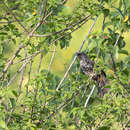Conservation
provided by Arkive
Hinde's babbler is classified as globally vulnerable (1). Only 8% of the known population of this babbler occurs inside legally protected areas at present (5). Surveys have been carried out to assess the range and status of this species in detail (4) (5). It is also essential that thicket areas are maintained and a public awareness programme is set up to inform people in the area of the importance of thickets for this declining species (4) (6).
Description
provided by Arkive
Hinde's babbler is a thrush-like bird that occurs in several colour forms. The body feathers are mainly dark grey-brown, edged with variable amounts of white, giving many individuals a 'frosted' appearance. Pale flecks and blotches are usually present, particularly on the head, neck, breast and back. In some birds, these markings tend to coalesce, forming irregular and sometimes asymmetric patches. Other, darker individuals have much less white on the head and breast and a rust coloured underside (2). The eyes of adults are orange-red but those of fledglings are grey or brown (6). Almost always seen in groups, it produces a loud, chattering call, but is often silent for long periods (2).
Habitat
provided by Arkive
This species is found in association with scrub in semi-arid areas, and in moist, fertile land largely cleared for agriculture, but retaining some thicket cover. In both situations the Hinde's babbler is normally found in close proximity to streams and rivers (3) (6).
Range
provided by Arkive
Endemic to central Kenya, where it is found mainly to the south of Mount Kenya and in the foothills of the Aberdares (4) (5). Small numbers have also been found in two protected areas: Meru National Park and Mwea National Reserve (5). It has a fragmented range; from 1990 to 2001 it was known from just seven sites, which appear to form three discrete blocks, supporting 78%, 11% and 10 % of the total population, respectively. The apparent isolation of these populations may increase the species' vulnerability to local extinction (5). The global population of this bird has recently been estimated at between 1,500-5,600 birds, but the true figure is probably closer to the lower estimate (5).
Status
provided by Arkive
Classified as Vulnerable (VU A1cd+2cd) on the IUCN Red List 2003 (1).
Threats
provided by Arkive
The threats facing this species include the widespread clearance of thickets due to the increasing human population in the area and the resulting increase in demand for agricultural land. Remaining thickets are becoming more isolated. Hunting for food and disturbance during the breeding season may also have an impact in some areas (4).
Hinde's babbler
provided by wikipedia EN
- license
- cc-by-sa-3.0
- copyright
- Wikipedia authors and editors
Hinde's babbler: Brief Summary
provided by wikipedia EN
Hinde's babbler (Turdoides hindei), also known as Hinde's pied-babbler, is a species of bird in the family Leiothrichidae. It is endemic to Kenya. Its natural habitats are subtropical or tropical moist shrubland, arable land, and plantations. It is threatened by habitat loss.
- license
- cc-by-sa-3.0
- copyright
- Wikipedia authors and editors

